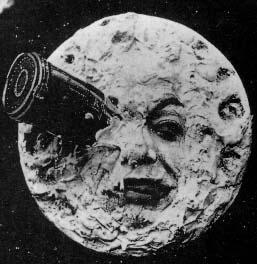Watching Georges Méliès’ Films the Old-Fashioned Way
Georges Méliès’ iconic image from “A Trip to the Moon”. (Photo: Wiki Commons)
Going to see a big Hollywood movie these days, you might end up putting on 3D glasses. Take Martin Scorsese’s 2011 movie “Hugo.” It was produced in 3D.
The film was based on the book “The Invention of Hugo Cabret.” But the story was inspired by the real French filmmaker Georges Méliès.
Méliès was a master of special effects. That’s turn of the 20th century special effects. He’s best known for his 1902 film “A Trip to the Moon” …you know, the one where a rocket pokes the moon in the eye.
Méliès was a showman – and his family continues the tradition to this day. They’ve taken his movies on tour of the US recently.
That’s what Madeleine Malthête-Méliès used to do. She is the granddaughter of Georges Méliès.
Marie-Hélène Lehérissey said many of the films are comedic and full of irony. Most of them starred Méliès himself, who always loved a good laugh. The films, she said, are whimsical, surprising and entertaining.
In short, these are not dusty old silent films.
Most of Méliès’ films use artful tricks, like a puff of smoke, to make people and things disappear right in front of your eyes. That’s why the Lehérisseys refer to him as a ‘CinéMagician.’ Take the two-minute film “The Brahmin and the Butterfly” from 1901. It shows a crude caterpillar enter a cocoon and reappear almost instantly as a beautiful woman with butterfly wings.
Lehérissey said this film is an audience favorite around the world. She would know; she and her son have taken their show everywhere, from Japan to South America.
In the US, many audience members are already familiar with the movie “Hugo,” and with Georges Méliès’ films—sometimes thanks to YouTube. But she said seeing the films in a live setting, gives them a new appreciation for these gems from the dawn of cinematography.
All without 3D.
The character Isabelle in “Hugo” is based on her.
Malthête-Méliès says her family loved “Hugo.” They saw it as an imaginative tribute to Georges Méliès.
Méliès made 500 films in his lifetime. But most of them were lost or destroyed during World War I.
So Malthête-Méliès has dedicated her life to finding and preserving what’s left of his body of work.
“No one was interested in film conservation until the late 1930s,” she said, “so I had to go around hunting for existing copies of those celluloid films, and then have them restored. I started with eight films, and today the family has more than 200.”
Madeleine Malthête-Méliès wanted to make sure her grandfather’s work wouldn’t be forgotten.
Theater performance runs in the family—so she went on tour with his silent films, presented with a narration and piano. The way it used to be.
She started after World War II, and kept at it for decades.
But now she’s 89 and she’s done with touring.
These days, it’s the daughter of one of her cousins who hits the road to present the films.
Marie-Hélène Lehérissey does what’s called “le boniment,” during screenings, the witty and sometimes mocking narration—like a carnival barker. Because those silent films didn’t have intertitles to explain the story.
She said she learned how to do the “boniment” from her grandfather, Georges’ son.
“My grandfather, André Méliès, was an opera singer, and he had a great memory,” she said, “so he remembered exactly what his father taught him about the tone and words for the films’ narration. He passed this on to my mother and me. When I was 20, he said, ‘I’m retiring, it’s your turn now.’ I was gobsmacked, but I did take on this role.”
Now her adult son Lawrence accompanies her on the piano. They’re the 4th and 5th generations of the Méliès family to do this.
“I kind of fell into this gig as a child,” Lawrence said. “I learned from watching others doing it. The idea is not to compete with the film but to help highlight the images and the action.”
Lawrence said it’s more like a live theatre performance than a movie screening.
Here’s what you would hear in Marie-Hélène’s narration of the opening scene for “A Trip to the Moon.” On screen, there’s a group of scientists in pointy hats and long white wigs in an observatory.
“We have the privilege of being invited to an extraordinary session of the Institute of Incoherent Astronomy. Scientists from around the world are gathering to discuss a new travel project, because going around the world has now become so passé.”
Later on, the scientists build a metal rocket ship and fly to the moon where they encounter some terrifying aliens who look like lobsters.
“A Trip to the Moon” (Voyage dans la lune, 1902)
We want to hear your feedback so we can keep improving our website, theworld.org. Please fill out this quick survey and let us know your thoughts (your answers will be anonymous). Thanks for your time!
